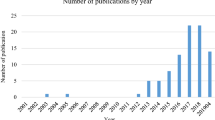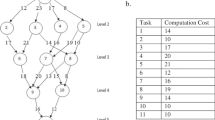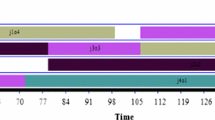Abstract
This paper presents a real-life scheduling problem of minimizing total weighted tardiness on identical parallel machines with eligibility constraints which is originated from the manufacturing plant of an industrial metal nuts company. Because the problem is NP-hard, a new electromagnetism-like mechanism algorithm is proposed to solve the problem. In the proposed algorithm, the particle is redesigned to represent jobs with valid assignment to machines. A distance measure between particles is proposed by the concept of a number-guessing game. Then, the new attraction and repulsion operators are developed to move a particle to the new particle. The computational results show that the proposed algorithm performs better than the current scheduling method of the metal nut plant and other existing algorithms.
Similar content being viewed by others
References
Hwang, H.C.; Chang, S.Y.; Lee, K.: Parallel machine scheduling under a grade of service provision. Comput. Oper. Res. 31, 2055–2061 (2004)
Lu, X.; Liu, Z.: Semi-online scheduling problems on two uniform machines under a grade of service provision. Theor. Comput. Sci. 489, 58–66 (2013)
Gokhale, R.; Mathirajan, M.: Scheduling identical parallel machines with machine eligibility restrictions to minimize total weighted flowtime in automobile gear manufacturing. Int. J. Adv. Manuf. Technol. 60, 1099–1110 (2012)
Chuang, M.C.; Liao, C.J.; Chao, C.W.: Parallel machine scheduling with preference of machines. Int. J. Prod. Res. 48, 4139–4152 (2010)
Glass, C.A.; Kellerer, H.: Parallel machine scheduling with job assignment restrictions. Nav. Res. Logist. 54, 250–257 (2007)
Ou, J.; Leung, J.Y.T.; Li, C.L.: Scheduling parallel machines with inclusive processing set restrictions. Nav. Res. Logist. 55, 328–338 (2008)
Ji, M.; Cheng, T.C.E.: An FPTAS for parallel-machine scheduling under a grade of service provision to minimize makespan. Inf. Process. Lett. 108, 171–174 (2008)
Woeginger, G.J.: A comment on parallel-machine scheduling under a grade of service provision to minimize makespan. Inf. Process. Lett. 109, 341–342 (2009)
Raghavan, N.S.; Venkataramana, M.: Parallel processor scheduling for minimizing total weighted tardiness using ant colony optimization. Int. J. Adv. Manuf. Technol. 41, 986–996 (2009)
Zhang, R.; Wu, C.: A divide-and-conquer strategy with particle swarm optimization for the job shop scheduling problem. Eng. Optim. 42, 641–670 (2010)
Hamidinia, A.; Khakabimamaghani, S.; Mazdeh, M.M.; Jafari, M.: A genetic algorithm for minimizing total tardiness/earliness of weighted jobs in a batched delivery system. Comput. Ind. Eng. 62, 29–38 (2012)
Lin, Y.K.; Pfund, M.E.; Fowler, J.W.: Heuristics for minimizing regular performance measures in unrelated parallel machine scheduling problems. Comput. Oper. Res. 38, 901–916 (2011)
Liaw, C.F.; Lin, Y.K.; Cheng, C.Y.; Chen, M.C.: Scheduling unrelated parallel machines to minimize total weighted tardiness. Comput. Oper. Res. 30, 1777–1789 (2003)
Birbil, S.I.; Fang, S.C.: An electromagnetism-like mechanism for global optimization. J. Glob. Optim. 25, 263–282 (2003)
Ali, M.M.; Golalikhani, M.: An electromagnetism-like method for nonlinearly constrained global optimization. Comput. Math. Appl. 60, 2279–2285 (2010)
Birbil, S.I.; Fang, S.C.; Sheu, R.L.: On the convergence of a population-based global optimization algorithm. J. Glob. Optim. 30, 301–318 (2005)
Chang, P.C.; Chen, S.H.; Fan, C.Y.: A hybrid electromagnetism-like algorithm for single machine scheduling problem. Expert Syst. Appl. 36, 1259–1267 (2009)
Debels, D.; Reyck, B.D.; Leus, R.; Vanhoucke, M.: A hybrid scatter search/electromagnetism meta-heuristic for project scheduling. Eur. J. Oper. Res. 169, 638–653 (2006)
Garcia-Villoria, A.; Moreno, P.R.: Solving the response time variability problem by means of the electromagnetism-like mechanism. Int. J. Prod. Res. 48, 6701–6714 (2010)
Guan, X.; Dai, X.; Qiu, B.; Li, J.: A revised electromagnetism-like mechanism for layout design of reconfigurable manufacturing system. Comput. Ind. Eng. 63, 98–108 (2012)
Yan, H.S.; Wan, X.Q.; Xiong, F.L.: A hybrid electromagnetism-like algorithm for two-stage assembly flow shop scheduling problem. Int. J. Prod. Res. 52, 5626–5639 (2014)
Gao, L.; Zhang, C.; Li, X.; Wang, L.: Discrete electromagnetism-like mechanism algorithm for assembly sequences planning. Int. J. Prod. Res. 52, 3485–3503 (2014)
Abed, I.A.; Koh, S.P.; Sahari, K.S.M.; Jagadeesh, P.; Tiong, S.K.: Optimization of the time of task scheduling for dual manipulators using a modified electromagnetism-like algorithm and genetic algorithm. Arab. J. Sci. Eng. 39, 6269–6285 (2014)
Chao, C.W.; Liao, C.J.: A discrete electromagnetism-like mechanism for single machine total weighted tardiness problem with sequence-dependent setup times. Appl. Soft Comput. 12, 3079–3087 (2012)
Mclendon, A.M.; Geiger, C.D.; Lodree, Jr, E.J.: Scheduling Parallel Machines with Machine Eligibility Restrictions Minimizing Total Weighted Tardiness. In: IIE Annual Conference. Proceedings. pp. 968. Institute of Industrial Engineers–Publisher (2007)
Kim, C.O.; Shin, H.J.: Scheduling jobs on parallel machines: a restricted tabu search approach. Int. J. Adv. Manuf. Technol. 22, 278–287 (2003)
Shim, S.O.; Kim, Y.D.: Minimizing total tardiness in an unrelated parallel-machine scheduling problem. J. Oper. Res. Soc. 58, 346–354 (2007)
Li, C.L.: Scheduling unit-length jobs with machine eligibility restrictions. Eur. J. Oper. Res. 174, 1325–1328 (2006)
Author information
Authors and Affiliations
Corresponding author
Rights and permissions
About this article
Cite this article
Lee, CH. A New Discrete Electromagnetism-Like Mechanism Algorithm for Identical Parallel Machine Scheduling Problem with Eligibility Constraints in Metal Nuts Manufacturing. Arab J Sci Eng 42, 3609–3620 (2017). https://doi.org/10.1007/s13369-017-2627-7
Received:
Accepted:
Published:
Issue Date:
DOI: https://doi.org/10.1007/s13369-017-2627-7




